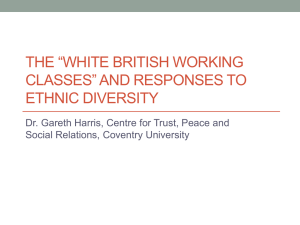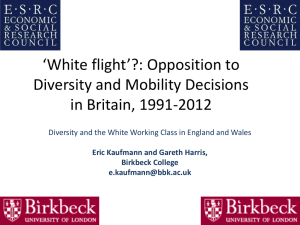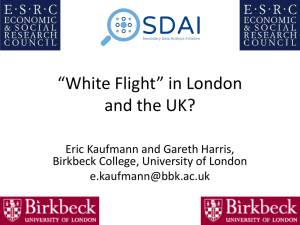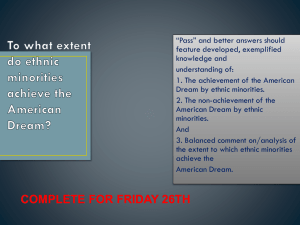Slide - Eric Kaufmann
advertisement
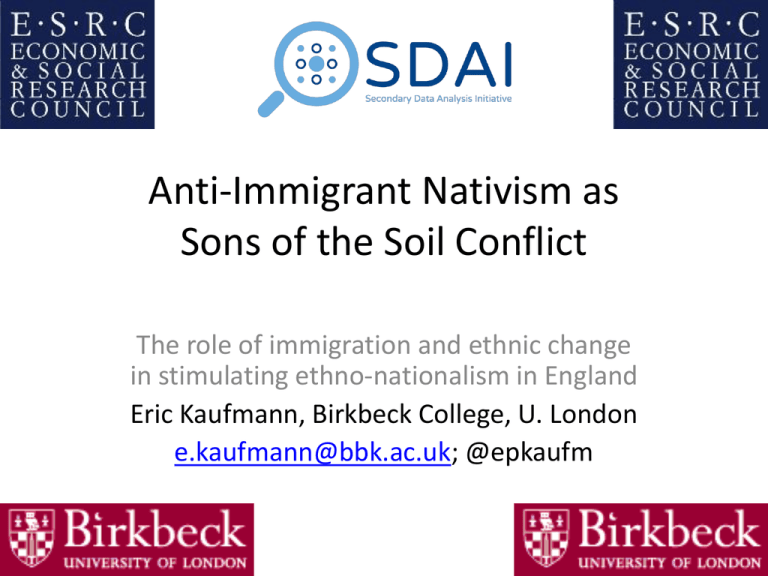
Anti-Immigrant Nativism as Sons of the Soil Conflict The role of immigration and ethnic change in stimulating ethno-nationalism in England Eric Kaufmann, Birkbeck College, U. London e.kaufmann@bbk.ac.uk; @epkaufm Sons of the Soil Residence and Rebellion: Mean Maximum Rebellion Scores by Category of Residence Has the Group Been in the Country Since 1800? Does the Group have a Regional Base? YES NO 2.9 1 (n=248) (n=50) 2.9 1.1 (n=276) (n=123) N.B. A score of 1 indicates no rebellion. N refers to number of such groups in the MAR dataset. Source: Fearon and Laitin 2011 Sons of the Soil Conflicts • Indigenousness (Eriksen 1993) • Dominant ethnicity; dominant ethnonationalism (Kaufmann 2004) • Ethno-nationalism includes a concern with individual migration/change • Autochthony: internal migration across ethnic boundaries, into ‘our’ land • West: international migration across ethnic/national boundaries, into ‘our’ land Other White British: Scots, Welsh, Irish, Ulster British White British: 77% of England Britain England: 84% of Britain English ethnic core: 73% of all people in England Cultural Liberalism Individualism - - English Ethnic Nationalism Integration/ Assimilation/ Boundary Shift + Immigration and Minority Growth Source: Ipsos MORI, 'Attitudes to Immigration' (forthcoming). Issues Index question: “What do you see as the most/other important issues facing Britain today?”. Issues Index base: representative sample of c.1,000 British adults age 18+ each month, interviewed face-to-face in home. Home Office statistics based on ‘Year ending’. Catholic % and Female Orange Membership, Scotland, 1855-2001 18 10000 16 9000 8000 14 7000 % Catholic 12 6000 10 5000 8 4000 6 4 2 0 % Catholic Female Orange Members 3000 2000 1000 0 Locality Matters • Nation could be the local writ large (Applegate 1990; Confino 1997; Zimmer 2013) • Local could be a passive space inscribed by national discourses • But then, why do opinions on national issues vary by locale, AND • Why are demographic changes to the nation experienced so differently by locale? Local Realities Shape Perceptions of the Nation (Kaufmann 2008) Nation Local White British opposition to immigration, by share of immigrants in ward 90.0% 85.0% 80.0% 75.0% Whites White Working Class 70.0% 65.0% 60.0% 55.0% 50.0% 15+% Immigrants 10-15% 5-10% 2-5% Less than 2% immigrants Source: Home Office Citizenship Survey (Office for National Statistics and Home Office 2011) Table 2. White British Discomfort Threshold for Minority Share, Ward-level, 2013 Source: Yougov 2013. Share of minorities beyond which person would become uncomfortable % of Respondents Cumulative Over 75% 5.6% 5.6% 75 3.4% 9.0% 66 6.8% 15.8% 50 19.0% 34.8% 25 16.5% 51.3% 17 5.7% 57.0% 10 13.9% 70.9% 5 11.3% 82.2% 2 6.3% 88.6% 1 2.2% 90.7% Less than 1% 1.7% 92.4% No minorities 3.1% 95.5% Don't know 4.5% 100.0% Number of • 'When do you think you would start to feel uncomfortable about the number of people from ethnic minorities… • A) ‘living in your neighbourhood’? • B) ‘living in Britain’? • .60 correlation Individualism • Mobility: Renter or recent mover v. long-term resident • Living in a transient area • Living in an urban area • Higher Education/Student • Higher social class • Importance of occupation for identity vs. importance of ethnicity/nation • Young Desire to reduce migration, by class and proportion of renters, among ward residents, white British only 90 85 80 75 70 65 60 55 50 45 40 Upper Middle Working Base Least Renters 2 3 4 Most Renters Source: Home Office Citizenship Survey (Office for National Statistics and Home Office 2010, 2011) Predictors of Desire to Reduce Immigration, MSOA level, White British Only Deprivation of MSOA Population Density in MSOA % Minorities (MSOA) % Minorities (Local Authority) Resident over 10 years (ref: less than… London Age renter living in social housing Student (upper ref.) Never worked (upper ref.) Working Class (upper ref.) Lower Supervisory Class (upper ref) Middle Class (upper ref.) No children (children ref.) single (couple ref.) No Qualifications Income Male -7 -5 -3 -1 1 predictive power (z-score) 3 5 7 Predictors of Opposition to Immigration, White British only Do not trust people English national identifier Tabloid reader Frequency of mixing w/other ethnic groups All friends are white British Broadsheet reader Ward population density Lower Supervisory class Nation important for self-identity Middle Class Ward transience Single Local Authority minority % No qualifications Ward minority % Age -8 -3 2 Predictive power (z score) 7 12 Predicted Probabilities for transience and diversity Predicted Probability of Favouring Reduction 90 85 80 75 70 65 Percentage minority population 2011 60 Percentage population churn 2001 55 -3 -2 -1 0 1 2 3 Distribution of Independent Variable (categories based on nested means method) Source: Harris 2012 Ward Characteristics Significantly Associated with White BNP voting, Greater London Authority election, 2008 0.40 S t d . B e t a 0.35 0.30 0.25 0.20 0.15 0.10 0.05 0.00 Source: Harris 2012 (census and election statistics) Predictors of UKIP and BNP/Far Right Support 2009-12 Lower Education Lower class Ward Deprivation Ward Minority Increase LA % Minority English identifier Low social trust UKIP Ward % White Other Far Right (mainly BNP) Income Ward Population Density Ward % Renters Ward % Minority Female Age -11 -9 -7 -5 -3 -1 1 3 5 z-score Source: Understanding Society survey, waves 1-3, 2009-12 7 9 Predictors of BNP and UKIP Combined Vote among whites, Ward level, Local Elections 2010-12 Local Authority (LA) minority increase % Minorities in LA 2012 % Agricultural sector 2011 2010 % Minorities in ward % Degrees -5 -4 -3 -2 -1 0 1 2 3 Predictive power (t-stat) Source: Election data from Plymouth Elections Centre Data; ONS 2013. http://www1.plymouth.ac.uk/research/ceres/TEC/thecentre/Pages/default.aspx 4 White Flight in Britain? Moved To Whiter Ward past 10 yrs Moved To More Diverse Ward past 10 yrs Sample Not White British 53% 47% 47 White British 62% 38% 239 Total 60% 40% 286 Movers from Diversity Movers to Diversity Stayer Immigration: Increase or same 23% 25% 17% Immigration: reduce a little 16% 21% 19% Immigration: reduce a lot 60% 54% 64% Number of cases 146 89 906 English Identity 43% 40% 50% Conservative Party 28% 25% 28% 148 91 927 21% 14% 23% 139 83 903 Number of cases Discomfort Interracial Marriage Number of cases Source: Yougov survey, August 2013 (Yougov 2013). N = 1638 white British adults. Note that number of cases is slightly different for different groups of variables depending on response rate Conclusion • Ethnic Change associated with English ethnic nationalism • Local ethnic dynamics matter for perceptions of national issues • Assimilation of European immigrants has historically reduced English ethnic nationalism • Local contact with and habituation to minorities, rather than integration, reduces opposition to immigration

